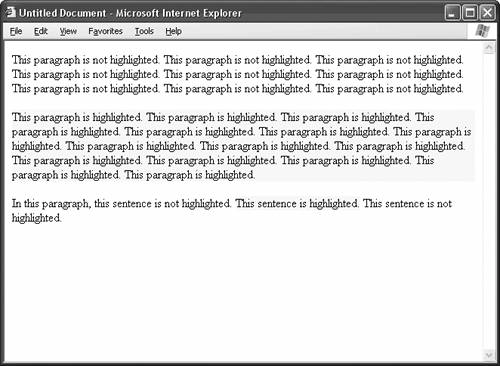Chapter 53. Highlighting Text with Color
| In Topic 5, you saw how to set the default text color of a Web page along with the default background color and link colors. This topic looks at how to change the color of specific text elements or pieces of text within an element without affecting the default text color. If you're one of those diehard Web designers who insist on using the font tag, you'll be happy to know that the color property of this tag does the job: <font face="Arial, Helvetica, sans-serif" color="#FF0000"> <h3>Note</h3> <p>You <strong>must</strong> supply your current email address.</p> </font> Just as the typeface of the font tag applies to all the text elements nested inside it, the font color also applies. In the preceding example, both the h3 tag and the paragraph tag acquire the color red (#FF0000), no matter what the default text color of the page happens to be. You can achieve the same effect with the color attribute of CSS: <h3 style="color: #FF0000;">Note</h3> <p style="color: #FF0000;">You <strong>must</strong> supply your current email address.</p>
If you need to change the color of a string of text within an element, either nest font tags inside the element:
or, for CSS, drop span tags around the text that you want to color:
CSS also gives you the ability to color the background area of a text element, creating an effect like a highlighter pen, as you can see in Figure 53.1. Listing 53.1. View Source for Figure[View full width] <p>This paragraph is not highlighted....</p> <p style="background-color: #FFFF00;">This paragraph is highlighted....</p> <p>In this paragraph, this sentence is not highlighted. <span style="background-color: Figure 53.1. CSS is as good as any highlighter pen. Changing the background color in this fashion usually makes more sense than changing the color of the type itself. You aren't as likely to trick your visitors into thinking that the text is a hyperlink. Why? Because you leverage the power of a metaphor.
Most people know what a printed page looks like when someone has gone over it with a highlighter pen. When you change the background color of a text element, the effect on screen looks very similar. Therefore, people tend to assume that your background color has the same functionto call attention to an important passage. When the text itself changes color, people tend to associate it with a different metaphor: the hyperlink. This spells nothing but trouble, because it confuses your audience. They click and click on the colored text, and nothing happens, because it isn't a hyperlink. It just looks like one.
|
- Challenging the Unpredictable: Changeable Order Management Systems
- ERP System Acquisition: A Process Model and Results From an Austrian Survey
- Intrinsic and Contextual Data Quality: The Effect of Media and Personal Involvement
- A Hybrid Clustering Technique to Improve Patient Data Quality
- Relevance and Micro-Relevance for the Professional as Determinants of IT-Diffusion and IT-Use in Healthcare